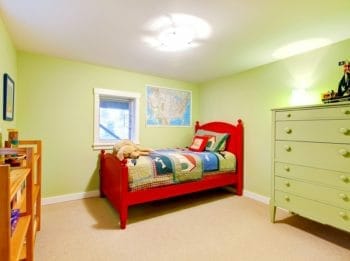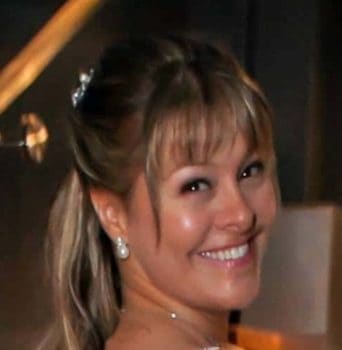Making sure that you have the proper bedroom accommodations for a foster child is an important step in the foster care application process. You may be asking yourself, can I foster a child with no spare bedroom?
You can foster a child with no spare bedroom, as sharing a bedroom with another child is permitted providing each child has a bed. Bunk beds are allowed, yet infants must sleep in a crib. The bedroom must have both a window and a door, as well as storage for personal belongings.
In most states, there is no specific size requirement for a child’s bedroom. However, there are many requirements for a child’s bedroom that need to be met.

Foster Child Privacy
Privacy is important to all of us, and foster children need privacy, too. A foster child’s bedroom should have a door that closes with no small holes for other children to peek through.
The bedroom must have true walls and not make-shift partitions set in place to look like a bedroom.
Privacy could be taken a step further as an option by providing a standing partition for the bedroom that the children sharing a room can use to stand behind when dressing.
Many children are shy and do not feel comfortable dressing in front of anyone, no matter who they are.
Would you like to take your foster child on a vacation with you but wondering how that works? Find out if traveling with your foster child is OK.
Firearms Are Locked and Out of Reach
Each state will have its specific requirements regarding the possession of firearms. In general, each state will want you to make sure that your firearm is unloaded while in storage.
Of course, locked firearms should never be located in a child’s bedroom.
Ammunition must be separate from firearms when stored. Just as the firearms must be locked and out of reach of your foster children, the ammunition must also be locked and out of reach.
If you find yourself in possession of a firearm while fostering or going through the foster care application process, you must inform the foster care agency of the firearm.
If practical, there should be a trigger lock on each firearm in the home.
For information on each state, visit an informative PDF called National Resource Center for Family-Centered Practice & Permanency Planning.
Considering becoming a foster parent? Learn the pros and cons and become fully informed.
Clean and Good Repair
Your home must be clean and in good repair. It would be a good idea to do a good, deep cleaning before you start the foster care application process so that your home is ready to be inspected.
This type of cleaning should extend beyond the bedroom and could be compared to what some refer to as spring cleaning.
Some deep cleaning examples are as follows:
- Get the carpets steam cleaned
- Clean both the inside and outside of your windows
- Pull out the fridge and clean behind and underneath of it
- Wipe down all interior walls
- Toss throw rugs into the washing machine
- Grab your broom and look for cobwebs up high on ceilings
- Mop your floors paying close attention to the edges of the floor as well as the molding that collects dust and grime
- Dust out-of-reach items such as ceiling fans and the top of the refrigerator
- Clean window sills and window jams
The outside of your home will need attention, too. Here are some things to take into consideration:
- Make sure the yard is clean of clutter
- Fill all holes in the yard to prevent tripping and injury
- Confirm the fencing is stable and secure to prevent a child from slipping outside of the yard
- Ensure that the siding on the outside of the home, as well as the gutters, are secure as to prevent something from falling onto the child
- Verify that any trees in your yard do not have questionable limbs that may fall causing injury
Storage For Personal Belongings
Each child will need a place of their own to store their personal belongings.
If you need storage ideas for a child’s personal belongings, we have some ideas that follow:
- Under-the-bed storage using storage bins
- Dressers for each child
- Cubbies
- Shelving with baskets or plastic bins
- Hanging nets for stuffed animals
- Nightstands for each child
There are multiple ways to provide a personal storage solution for each child. It is amazing what can be done if the time is taken to be a bit creative.
Reliable and Safe Heating and Cooling
You do not want your foster child to crawl into his or her bed shivering because they cannot get warm.
Or being so hot from the summer heat that they wonder how they will get through the miserable night.
Having a reliable heating and cooling system is a must. Not only should they be in good working order, but a foster parent is also responsible for actually using them to keep the home comfortable.
No child should have to freeze or die of heatstroke unnecessarily because there is an effort to keep the utility bill costs down.
With proper home insulation and heating and cooling maintenance upkeep, your heating and cooling systems should be running efficiently to provide a level of comfort while also giving you the efficiency you need for your budget.
You may have heard some negative things about the foster care system, but how bad is it really?
Secure Window Screens
One thing we cannot leave out is the importance of secure window screens.
Sadly, children have fallen out of windows and have either died or have been badly hurt from leaning on a window screen that was not securely in place.
Even if your home is one level and your child will not be severely injured from falling out of the window, having a secure window screen is not optional when wanting to foster a child.
Number of Children Per Room
Slightly more than a third of the states do not have a specific maximum number of children that can be in one bedroom.
If the bedroom is large enough to accommodate a child’s needs such as their bed, closet space, and their place to store their personal belongings, this might make sense.
Just less than two-thirds of the other states, however, do have a set maximum of how many children are allowed in one bedroom with most allowing no more than two children per room.
As with anything else, some exceptions may apply.
In many states, infants are allowed to sleep in their parent’s bedrooms until they have reached an age where they are no longer considered infants.
Generally, the child is considered no longer an infant when the child reaches the age of two years of age.
They will then need to be moved into a different bedroom that meets all appropriate guidelines.
In all states, having children of the opposite gender in the same bedroom is strongly discouraged and generally not allowed.
Beds
The bed requirements for foster children are pretty straightforward. Each child must be provided their own bed. Beds may take the form of a traditional bed on a traditional frame with a box spring.
Daybeds, bunk beds, and cribs are also considered acceptable bed types.
Important to note is that infants are required to be in a crib.
Closets for Clothing
A physical closet itself is more of a requirement geared toward real estate where potential homeowners would naturally want each bedroom to have a closet.
However, for foster child purposes, a closet is not mandatory as must as a place for a child to have a place to store their clothing.
Some alternate ways of storing clothing without a closet follow:
- Using a combination of dresses, rods, and shelves
- Add curtains overexposed hanging clothing to hide a cluttered look
- Purchase clothing racks
- Large baskets under beds
- Install piles to use as clothing rods
- Clothes hanging rack and shelving storage behind a bed near headboard area
This is by no means a complete list of bedroom requirements for foster children, but it does provide a good idea of the things that will need to be addressed when preparing your home to foster a child.

About the Author:
Trina Greenfield is passionate about providing information to those considering growing their family. Trina does not run an adoption agency. Her website is strictly information-based, so she is able to provide unbiased, credible information that she hopes will help guide those along their journey.
